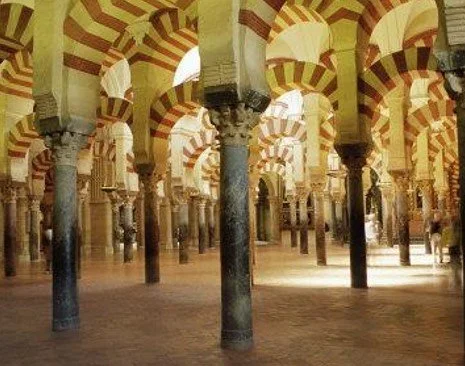Cordoba’s Mosque & Cathedral (Part II)
The Great Mosque was constructed on the orders of Abd ar-Rahman I in 785 CE, when Córdoba was the capital of the Muslim-controlled region of Al-Andalus.
The structure was expanded multiple times afterwards under Abd ar-Rahman's successors up to the late 10th century. Among the most notable additions, Abd ar-Rahman III added a minaret (finished in 958) and his son Al-Hakam II added a richly-decorated new mihrab and maqsura section (finished in 971).
The mosque was converted to a cathedral in 1236 when Córdoba was captured by the Christian forces of Castile during the Reconquista. It is fortunate that the Catholic Kings, Ferdinand and Isabella, didn’t order the mosque demolished before building their cathedral on its foot print. The construction was integrated into and with the Mosque.
The structure itself underwent only minor modifications until a major building project in the 16th century inserted a new Renaissance cathedral central aisle leading to the alter down the center of the building. The former minaret, which had been converted to a bell tower, was also significantly remodeled around this time. Starting in the 19th century, modern restorations have in turn led to the recovery and study of some of the building's Islamic-era elements.
The most striking image that catches the eye when you first walk in are the multitude of red and white arches; roughly 1300 columns and 760 arches in total, of differing height and material. The differences are not noticeable unless someone points them out to you.
Cordoba’s Grand Mosque With its Beautiful Arches
The Mihrab (the point closest to Mecca) is situated in the heart of the qibla wall. It is located between the doors of the Treasury Chambers and the Sabat. It is, the point that indicates the direction of prayer. It's also where the visitor's gaze is drawn, awestruck by its wealth and creativity.
Interior of the Mosque - The Mihrab
The Villaviciosa chapel was the first primary chapel of Córdoba's Mosque-Cathedral. The chapel was built between 1486 and 1496 under the reign of Alhakén II, thanks to the support of the Bishop of Córdoba Igo Manrique de Lara and the presence of Queen Isabel I the Catholic in Córdoba. It was the first major renovation to the Islamic Mosque, After the Christian invasion of the city in the 13th century.
The execution of the first significant Christian alteration to the structure was made with the construction of a large central part of the church. The basilica space of the Villaviciosa Chapel is beautified with pointed transversal arches pillars with detailed work, while a wooden gabled frame forms the ceiling. The ceiling was further decorated with pictorial motifs and inscriptions.
The Main Catholic Alter Within the Mosque
It still serves as an active and vibrant church for the Cordovan faithful with Mass celebrated therein daily.
I can go on forever about the magnificent Mosque-Cathedral, but it is for you to see in person and to absorb the history and artistic beauty of it all.



